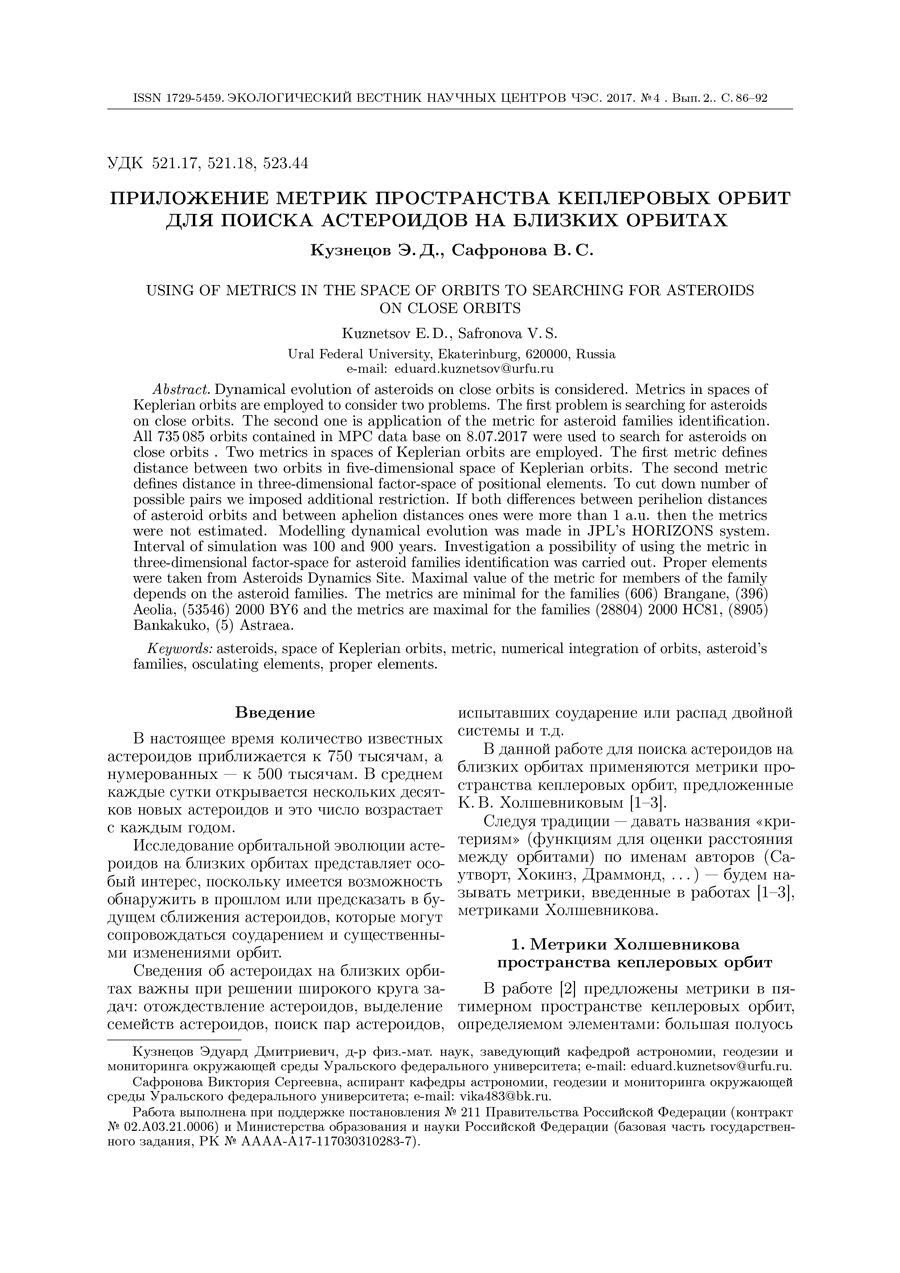Using of metrics in the space of orbits to searching for asteroids on close orbits
UDC
521.17, 521.18, 523.44Abstract
Dynamical evolution of asteroids on close orbits is considered. Metrics in spaces of Keplerian orbits are employed to consider two problems. The first problem is searching for asteroids on close orbits. The second one is application of the metric for asteroid families identification. All 735085 orbits contained in MPC data base on 07.08.2017 were used to search for asteroids on close orbits. Two metrics in spaces of Keplerian orbits are employed. The first metric defines distance between two orbits in five-dimensional space of Keplerian orbits. The second metric defines distance in three-dimensional factor-space of positional elements. To cut down number of possible pairs we imposed additional restriction. If both differences between perihelion distances of asteroid orbits and between aphelion distances ones were more than 1 a.u. then the metrics were not estimated. Modelling dynamical evolution was made in JPL's HORIZONS system. Interval of simulation was 100 and 900 years. Investigation a possibility of using the metric in three-dimensional factor-space for asteroid families identification was carried out. Proper elements were taken from Asteroids Dynamics Site. Maximal value of the metric for members of the family depends on the asteroid families. The metrics are minimal for the families (606) Brangane, (396) Aeolia, (53546) 2000 BY6 and the metrics are maximal for the families (28804) 2000 HC81, (8905) Bankakuko, (5) Astraea.
Keywords:
asteroids, space of Keplerian orbits, metric, numerical integration of orbits, asteroid's families, osculating elements, proper elementsAcknowledgement
References
- Kholshevnikov K.V. O metrikakh v prostranstvakh keplerovskikh orbit [On metrics in the space of Keplerian orbits]. In: Fizika kosmosa: Trudy 45 Mezhdunarodnoj studencheskoj nauchnoj konferentsii, Ekaterinburg, 1-5 fevralya 2016 g. [Physics of space: Proceedings of 45th International student scientific conference, Ekaterinburg, 1-5 February 2016], Ekaterinburg, Ural University Press, 2016, pp. 168-184. (In Russian)
- Kholshevnikov K.V., Kokhirova G.I., Babadzhanov P.B., Khamroev U.H. Metrics in the space of orbits and their application to searching for celestial objects of common origin. Mon. Not. R. Astron. Soc., 2016, vol. 25, pp. 2275-2283. doi: 10.1093/mnras/stw1712
- Kokhirova G.I., Babadzhanov P.B., Khamroev U.H., Kholshevnikov K.V., Milanov D.V. Poisk nebesnykh tel obshchego proiskhozhdeniya: metricheskij podkhod [Search of celestial bodies of common origin: metrical approach]. Ekologicheskij vestnik nauchnykh tsentrov Chernomorskogo ekonomicheskogo sotrudnichestva [Ecological bulletin of research centers of the Black Sea economic cooperation], 2017, Preprint. (In Russian)
- Vokrouhlicky D., Bottke W.F., Chesley S.R., Scheeres D.J., Statler T.S. The Yarkovsky and YORP effects. Michel P., DeMeo F.E., Bottke W.F. (eds.) Asteroids IV. Tucson, University of Arizona Press, 2015, pp. 509-531. doi: 10.2458/azu_uapress_9780816532131-ch027
- Minor Planet Center. URL: http:// www.minorplanetcenter.net
- HORIZONS Web-Interface. URL: https://ssd.jpl.nasa.gov/horizons.cgi\#top
- Shustov B.M., Rykhlova L.V. (eds.) Asteroidno-kometnaya opasnost’: vchera, segodnya, zavtra [Asteroid-Comet Impact Hazard: Past, Today, and Tomorrow]. Moscow, Fizmatlit, 2010. 383 p. (In Russian).
- Masiero J.R., DeMeo F.E., Kasuga T., Parker A.H. Asteroid family physical properties. Michel P., DeMeo F.E., Bottke W.F. (eds.) Asteroids IV. Tucson, University of Arizona Press, 2015, pp. 509-531. doi: 10.2458/azu_uapress_9780816532131-ch017
- Milani A., Knezevic Z. Asteroid mean elements: higher order and iterative theories. Celest. Mech. Dyn. Astr., 1998, vol. 71, pp. 55-78. doi: 10.1023/A:1008315029975
- Asteroids Dynamic Site. URL: http://hamilton.dm.unipi.it/astdys
Downloads
Issue
Pages
Submitted
Published
How to Cite
Copyright (c) 2017 Kuznetsov E.D., Safronova V.S.

This work is licensed under a Creative Commons Attribution 4.0 International License.




